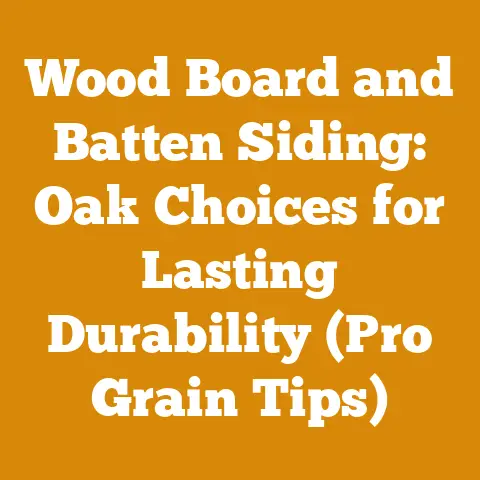Cedar Porch Post Ideas (5 Expert Tips for Durable Woodwork)
Cedar Porch Post Ideas (5 Expert Tips for Durable Woodwork)
Your porch posts are more than just supports; they’re the handshake of your home.
I’ve seen too many beautiful homes marred by rotting, unsightly porch posts. It’s a tragedy, really. After years spent felling trees, milling lumber, and crafting wood into something beautiful, the thought of it succumbing to the elements before its time is enough to make any woodworker’s blood boil. That’s why I’m sharing my top 5 expert tips for using cedar to create porch posts that not only look stunning but stand the test of time.
Let’s dive in and explore how to turn cedar into enduring pillars of your home’s curb appeal.
Why Cedar for Porch Posts? The Woodworker’s Choice
Before we get into the nitty-gritty of building, let’s talk about why cedar is such a fantastic choice for porch posts. I’ve worked with nearly every type of wood imaginable, from dense hardwoods like oak to softwoods like pine. But cedar? Cedar holds a special place in my heart.
Cedar’s inherent properties make it naturally resistant to rot, decay, and insect infestation. This is thanks to the natural oils within the wood, specifically thujaplicins. These oils act as a built-in preservative, protecting the wood from the elements and those pesky critters that love to make a meal out of your woodwork.
I remember one particularly humid summer in the Appalachian Mountains. I was working on a cabin restoration, and we had both pine and cedar lumber on site. The pine, despite being treated, showed signs of mildew within weeks. The cedar, on the other hand, remained pristine. That experience solidified my respect for cedar’s natural durability.
Consider these data points:
- Rot Resistance: Cedar, particularly Western Red Cedar, is classified as “durable” to “very durable” in terms of rot resistance by the USDA Forest Products Laboratory. This means it can last for decades with minimal maintenance, even in damp environments.
- Insect Resistance: The thujaplicins in cedar are toxic to many wood-boring insects, including termites and carpenter ants. Studies have shown that cedar heartwood can repel termites for up to 25 years.
- Dimensional Stability: Cedar has a low shrinkage rate compared to other woods, meaning it’s less likely to warp, crack, or split as it dries. This is crucial for porch posts, which are constantly exposed to fluctuating temperatures and humidity levels.
Beyond its practical benefits, cedar is also a beautiful wood. Its warm, reddish-brown hue and tight grain pattern add a touch of rustic elegance to any home. Plus, it’s easy to work with, making it a favorite among both amateur and professional woodworkers.
Tip #1: Selecting the Right Cedar Grade and Type
Not all cedar is created equal. I’ve learned this the hard way, using lower grades on projects only to see them fail prematurely.
Western Red Cedar vs. Eastern White Cedar
The two most common types of cedar used for woodworking are Western Red Cedar and Eastern White Cedar. While both are excellent choices, there are some key differences to consider.
- Western Red Cedar: This is the king of cedars, known for its superior rot resistance, rich color, and exceptional dimensional stability. It’s also more readily available in larger dimensions, making it ideal for porch posts. I often use Western Red Cedar for projects that demand the highest level of durability and aesthetic appeal.
- Eastern White Cedar: This cedar is lighter in color and slightly less durable than Western Red Cedar. However, it’s still a great option for porch posts, especially if you’re on a budget. Eastern White Cedar is also easier to work with, as it’s softer and less prone to splintering.
Understanding Cedar Grades
Cedar lumber is graded based on its appearance and the presence of knots, wane (bark edges), and other imperfections. The higher the grade, the fewer imperfections and the more uniform the color and grain.
Here’s a breakdown of the common cedar grades:
- Clear Vertical Grain (CVG): This is the highest grade of cedar, prized for its straight, tight grain and lack of knots. It’s the most expensive option but offers the best appearance and dimensional stability. I reserve CVG cedar for high-end projects where aesthetics are paramount.
- Clear: This grade is similar to CVG but allows for some minor imperfections, such as small knots or pitch pockets. It’s still a very high-quality option and a good choice for porch posts.
- Select Knotty: This grade features knots that are sound and tight. While it’s not as visually appealing as clear cedar, it can add character to your porch posts. Select Knotty cedar is also more affordable than clear grades.
- Common: This is the lowest grade of cedar, with numerous knots, wane, and other imperfections. I generally avoid using common cedar for porch posts, as it’s less durable and aesthetically pleasing.
My Recommendation: For porch posts, I recommend using either Clear Vertical Grain or Clear cedar. If you’re on a budget, Select Knotty can be a good option, but be sure to choose pieces with sound, tight knots.
Tip #2: Proper Sealing and Finishing Techniques
Even though cedar is naturally rot-resistant, it’s still crucial to seal and finish your porch posts properly to protect them from the elements and extend their lifespan. I’ve seen firsthand how a good finish can make a world of difference, turning a good post into a great, long-lasting one.
Choosing the Right Sealant
The first step in protecting your cedar porch posts is to apply a high-quality sealant. This will help to prevent moisture from penetrating the wood and causing rot or decay.
Here are some of the best sealants for cedar:
- Oil-Based Sealants: These sealants penetrate deeply into the wood, providing excellent protection against moisture. They also enhance the natural beauty of the cedar, giving it a warm, rich glow. I often use oil-based sealants for projects where I want to highlight the wood’s natural grain.
- Water-Based Sealants: These sealants are more environmentally friendly than oil-based sealants and are easier to clean up. They also dry faster and are less likely to yellow over time.
- Spar Urethane: This type of sealant is designed specifically for exterior wood applications. It’s highly resistant to moisture, UV rays, and abrasion, making it an excellent choice for porch posts.
My Recommendation: I prefer using a high-quality oil-based sealant for my cedar porch posts. It provides excellent protection and enhances the natural beauty of the wood. However, if you’re concerned about VOCs or cleanup, a water-based sealant is a good alternative.
Applying the Sealant
Before applying the sealant, make sure the wood is clean, dry, and free of any dust or debris. Use a brush, roller, or sprayer to apply the sealant evenly, following the manufacturer’s instructions.
I always apply at least two coats of sealant, allowing each coat to dry completely before applying the next. For areas that are particularly exposed to the elements, such as the base of the post, I may apply three coats.
Choosing the Right Finish
After sealing your cedar porch posts, you’ll want to apply a finish to protect them from UV rays and add a touch of color or sheen.
Here are some of the best finishes for cedar:
- Exterior Paint: This is the most durable option for protecting your cedar porch posts. It provides excellent UV protection and can be tinted to any color you desire.
- Exterior Stain: This finish allows the natural grain of the cedar to show through while adding a touch of color and UV protection.
- Clear Coat: This finish provides a clear, protective layer over the sealant, allowing the natural beauty of the cedar to shine through.
My Recommendation: For maximum durability and UV protection, I recommend using an exterior paint specifically formulated for wood. If you prefer to see the natural grain of the cedar, an exterior stain is a good option. However, be sure to choose a stain with UV inhibitors to prevent fading and discoloration.
Maintaining Your Finish
Even with the best sealant and finish, your cedar porch posts will require some maintenance over time. Inspect them regularly for signs of wear and tear, such as cracking, peeling, or fading.
If you notice any damage, sand the affected area and reapply the sealant and finish. With proper care and maintenance, your cedar porch posts can last for decades.
Tip #3: Designing for Water Runoff and Ventilation
One of the biggest threats to wooden porch posts is water. Standing water can seep into the wood, leading to rot, decay, and insect infestation. That’s why it’s crucial to design your porch posts to promote water runoff and ventilation.
Angled Tops
One simple but effective way to prevent water from pooling on top of your porch posts is to angle the tops slightly. This will allow water to run off easily, preventing it from seeping into the wood.
I typically angle the tops of my porch posts at a 5-degree angle. This is enough to promote water runoff without being too noticeable.
Drip Edges
Another way to prevent water from running down the sides of your porch posts is to install drip edges. These are small, overhanging edges that divert water away from the post.
Drip edges can be made from wood, metal, or plastic. I prefer using wood drip edges, as they blend in seamlessly with the cedar porch posts.
Ventilation
Proper ventilation is also crucial for preventing moisture buildup in your porch posts. This is especially important in humid climates.
Here are some ways to improve ventilation:
- Spacing: Leave a small gap between the porch post and the porch floor or roof. This will allow air to circulate freely around the post.
- Vents: Install small vents at the top and bottom of the porch post. This will allow air to flow through the post, preventing moisture buildup.
- Open Design: Avoid wrapping the porch post in solid materials, such as siding or trim. This will restrict airflow and trap moisture.
My Recommendation: I always incorporate angled tops, drip edges, and ventilation into my porch post designs. These simple measures can significantly extend the lifespan of your porch posts.
Tip #4: Choosing the Right Fasteners and Hardware
The fasteners and hardware you use to build your cedar porch posts are just as important as the wood itself. Using the wrong fasteners can lead to corrosion, staining, and structural failure.
Stainless Steel Fasteners
For cedar porch posts, I always recommend using stainless steel fasteners. Stainless steel is highly resistant to corrosion, even in damp environments. This will prevent the fasteners from rusting and staining the cedar.
I prefer using stainless steel screws for most of my porch post construction. Screws provide a stronger, more secure connection than nails.
Galvanized Hardware
If you’re using any metal hardware, such as post bases or brackets, be sure to choose galvanized hardware. Galvanization is a process that coats the metal with a layer of zinc, which protects it from corrosion.
I always use galvanized post bases to attach my porch posts to the porch floor. These bases provide a strong, stable connection and prevent the wood from coming into direct contact with the concrete.
Avoiding Dissimilar Metals
It’s important to avoid using dissimilar metals in your porch post construction. When two different metals come into contact in a damp environment, they can create a galvanic reaction, which can lead to corrosion.
For example, avoid using aluminum nails with copper flashing. The aluminum will corrode quickly in the presence of copper.
My Recommendation: Stick to stainless steel fasteners and galvanized hardware for your cedar porch posts. This will ensure a long-lasting, corrosion-resistant connection.
Tip #5: Professional Installation and Support
Even with the best materials and techniques, your cedar porch posts won’t last long if they’re not installed properly. Proper installation is crucial for ensuring the structural integrity and longevity of your porch posts.
Level and Plumb
The first step in installing your porch posts is to ensure that they’re level and plumb. Use a level to check that the posts are perfectly vertical. Use a plumb bob to check that they’re aligned with the porch floor and roof.
If the posts are not level and plumb, they can put undue stress on the structure, leading to premature failure.
Proper Footings
The porch posts should be supported by proper footings that extend below the frost line. This will prevent the posts from heaving or settling with the changing seasons.
The size and depth of the footings will depend on the size of the porch posts and the soil conditions in your area. Consult with a local building inspector or structural engineer to determine the appropriate footing requirements.
Adequate Support
The porch posts should be adequately supported by the porch floor and roof. This will prevent the posts from swaying or buckling under load.
Use proper bracing and connections to ensure that the posts are securely attached to the floor and roof. Consult with a structural engineer to determine the appropriate support requirements.
Hiring a Professional
If you’re not comfortable installing your porch posts yourself, it’s best to hire a professional contractor. A qualified contractor will have the experience and expertise to install your porch posts correctly and ensure that they meet all local building codes.
Proper installation is essential for ensuring the longevity and structural integrity of your cedar porch posts. If you’re not confident in your ability to install the posts yourself, hire a professional.
Case Study: The Cedar Porch Revival
I once worked on a project where a homeowner wanted to replace their old, rotting porch posts with new cedar posts. The original posts were made of treated pine, but they had succumbed to rot after just a few years.
We replaced the pine posts with Western Red Cedar posts, using stainless steel fasteners and galvanized hardware. We also incorporated angled tops, drip edges, and ventilation into the design.
The homeowner was thrilled with the results. The new cedar porch posts not only looked beautiful but also provided a much more durable and long-lasting solution.
Key Components of the Project:
- Equipment Used: Chainsaw, miter saw, drill, level, plumb bob, measuring tape, brushes, rollers.
- Wood Type: Western Red Cedar (Clear Vertical Grain).
- Safety Considerations: Wear safety glasses, gloves, and a dust mask when working with wood. Follow all safety instructions for power tools.
- Processing Methods: Cut cedar lumber to size, shape tops at a 5-degree angle, apply sealant and finish.
- Installation: Ensure posts are level and plumb, secure to porch floor and roof with galvanized post bases and brackets.
The Wrap-Up: Cedar Porch Post Longevity
Building with cedar is an investment in your home’s beauty and durability. By following these five expert tips, you can create porch posts that will not only enhance your home’s curb appeal but also stand the test of time.
Remember, the key to success is to choose the right cedar grade and type, seal and finish the wood properly, design for water runoff and ventilation, use the right fasteners and hardware, and ensure professional installation and support.
I hope this guide has been helpful. Now get out there and start building your dream porch!






